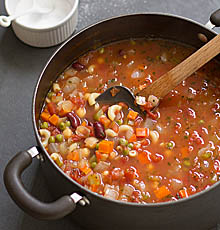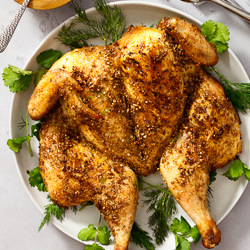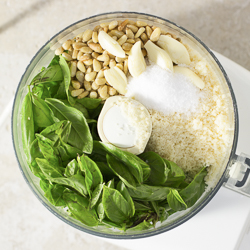Dry brining is definitely my new favorite thing. It’s absolutely the way to go with a Thanksgiving turkey, helping to make it juicier and more flavorful and sooo much easier than a wet brine. But don’t stop there—I recommend dry brining for all roasts and even smaller meats like steaks, chops, chicken, and more. To learn more about what’s so great about dry brining and how to do it, read this post.
As for this particular recipe, in addition to salt, the brine features a little sugar plus my personal favorite dried herb blend, herbes de Provence. It has a soft spot in my heart because it’s what we used to season the turkey for roast turkey sandwiches at the café I owned about a thousand years ago, and it definitely gave those sandwiches a special flair. (I also use on roast chicken.) If you’re not familiar with herbes de Provence, look for it in the spice section of most major supermarkets and at specialty food stores. That said, you can absolutely substitute your own favorite dried herbs—rosemary, sage, thyme, marjoram, oregano, or a combination would all be wonderful. You can even turn the recipe into Really Simple Dry-Brined Turkey by just skipping the herbs altogether. And it’ll still be delicious.
Serves 8 to 12
- 3 tablespoons kosher salt (see notes)
- 1 tablespoon herbes de Provence, or any other dried herbs or dried herb combination
- 1 tablespoon sugar
- 1 1/2 teaspoons freshly ground black pepper
- One 12- to 14-pound turkey, thawed, neck and giblets removed (see notes)
- 1 lemon, halved, or 1/2 orange, halved (into quarters)
- 1/2 onion, cut in halved (into quarters)
- About 2 cups white wine and/or low-sodium chicken or turkey broth
- 1/4 cup olive oil
In a small bowl, combine the salt, herbs, sugar, and pepper.
Use paper towels to pat the turkey dry inside and out.
Gently slip your fingers under the skin and rub in about half of the salt mixture, distributing it evenly over the meat. (With some birds, this can be challenging. Just do your best and don't worry about it too much.) Sprinkle about half of the remaining mixture inside the turkey, then sprinkle the rest all over the outside.
Arrange the turkey on a rack in a roasting pan, tuck the wing tips under, and loosely truss the legs (if they aren’t already). Set the turkey aside in the refrigerator, ideally uncovered, for 1 to 3 days.
When you’re ready to cook, set the turkey aside at room temperature for 1 hour. Meanwhile, preheat the oven to 400°F.
Place the lemon and onion inside the turkey. Pour enough wine and/or broth into the roasting pan to cover the bottom by 1/4 inch. Loosely tent the turkey with foil and roast it for 45 minutes.
Baste the turkey with the pan juices and continue roasting uncovered for 45 minutes.
Baste the turkey with the olive oil and continue roasting, basting about every 30 to 45 minutes, until an internal thermometer inserted in the thickest part of the thigh reads 165°F, 2 to 2 1/2 hours total cooking time. (If the pan gets dry, add more wine, broth, or water to maintain 1/8 to 1/4 inch of liquid. If any part of the turkey gets too brown, cover it loosely with foil.)
Let the turkey rest, loosely covered with foil, for 20 to 30 minutes before carving.
Serve the turkey drizzled with the pan drippings or use the pan drippings to make gravy.
Notes: Make sure to use a turkey that isn’t hasn’t been pre-salted, brined, pre-basted, or been in any flavoring solution (like a Butterball). Also avoid kosher turkeys. All those have essentially been salted or wet-brined already, so if you dry-brined them, they’d be waaay too salty.
I use Diamond Crystal Kosher Salt. If you use Morton’s Kosher Salt, use about 2 tablespoons.









